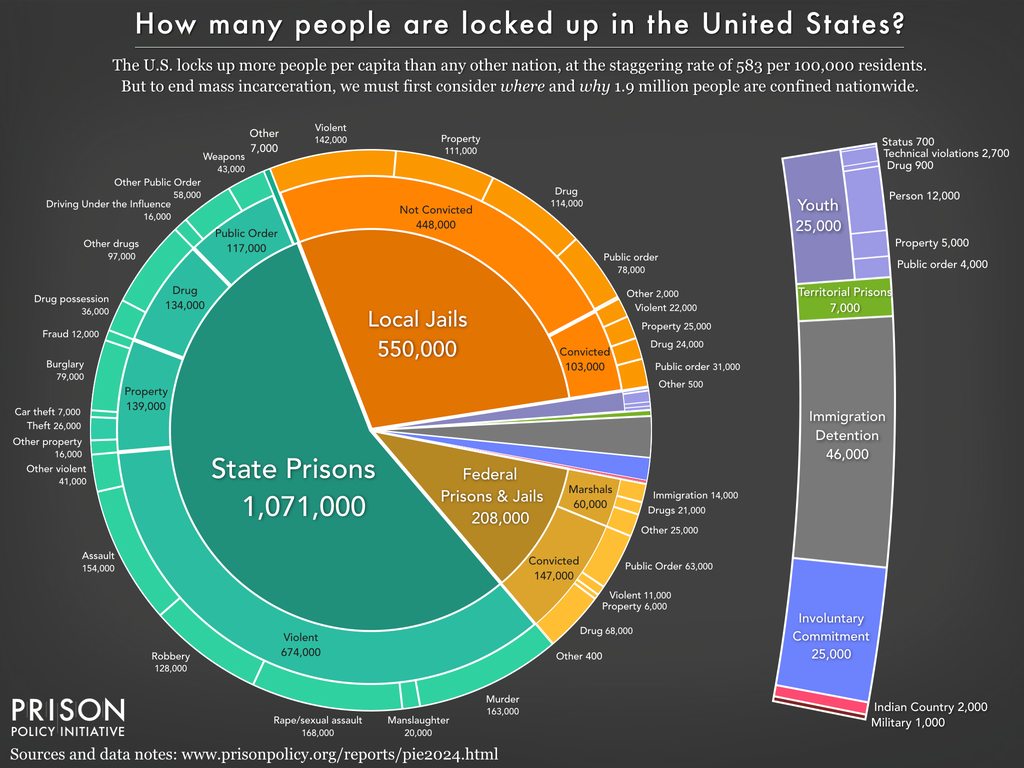
Can it really be true that most people in jail are legally innocent? How much of mass incarceration is a result of the war on drugs, or the profit motives of private prisons? Have popular reforms really triggered a crime wave? These essential questions are harder to answer than you might expect. The various government agencies involved in the criminal legal system collect a lot of data, but very little is designed to help policymakers or the public understand what’s going on. The uncertainty that results muddies the waters around our society’s use of incarceration, giving lawmakers and lobbyists the opportunity to advance harmful policies that do not make us safe. As criminal legal system reforms become increasingly central to political debate — and are even scapegoated to resurrect old, ineffective “tough on crime” policies — it’s more important than ever that we get the facts straight and understand the big picture.
Further complicating matters is the fact that the U.S. doesn’t have one criminal legal system; instead, we have thousands of federal, state, local, and tribal systems. Together, these systems hold over 1.9 million people in 1,566 state prisons, 98 federal prisons, 3,116 local jails, 1,323 juvenile correctional facilities, 142 immigration detention facilities, and 80 Indian country jails, as well as in military prisons, civil commitment centers, state psychiatric hospitals, and prisons in the U.S. territories — at a system-wide cost of at least $182 billion each year. 1 2
This report offers some much-needed clarity by piecing together the data about this country’s disparate systems of confinement. It provides a detailed look at where and why people are locked up in the U.S., and dispels some common myths about mass incarceration to focus attention on overlooked issues that urgently require reform.

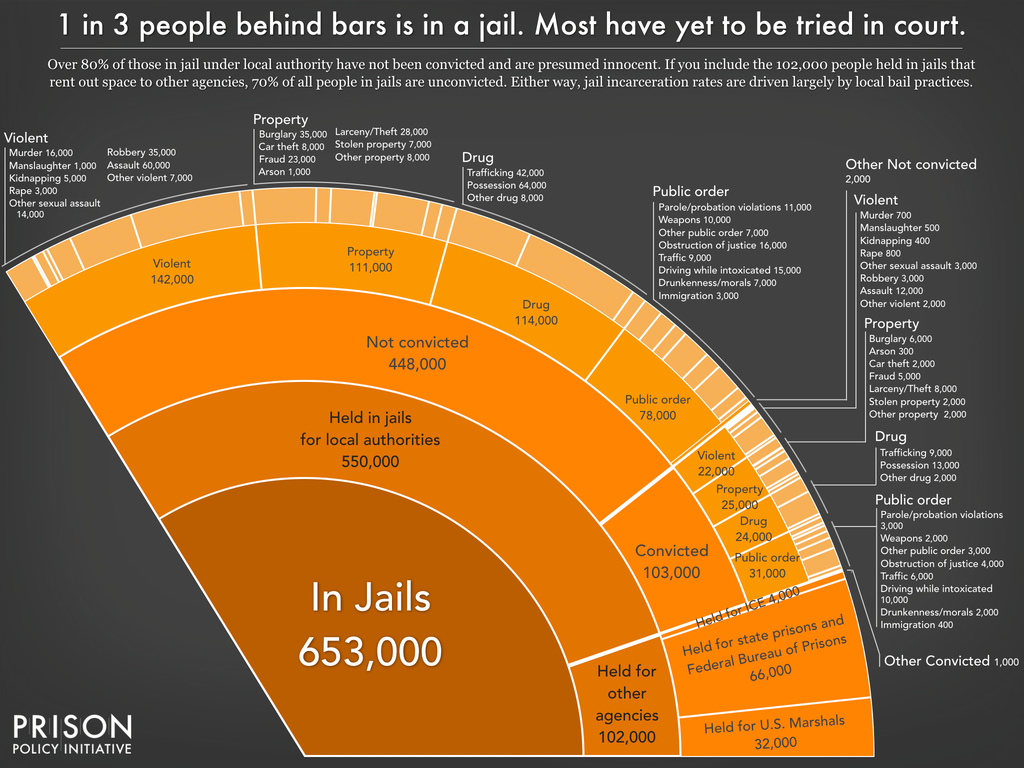
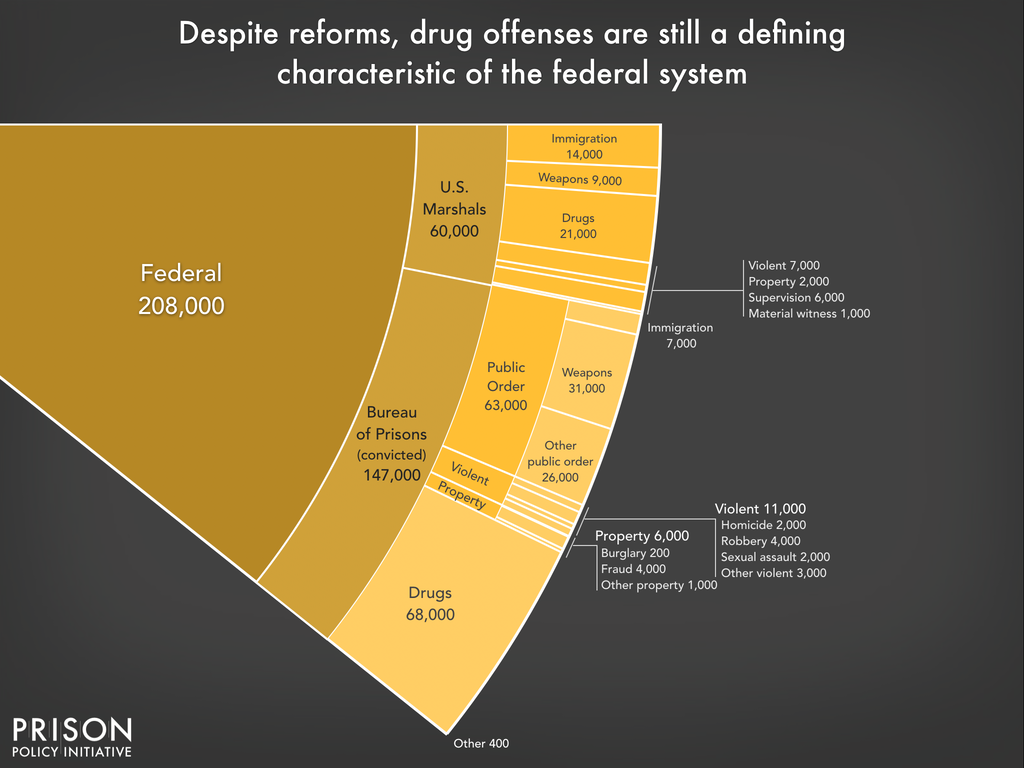
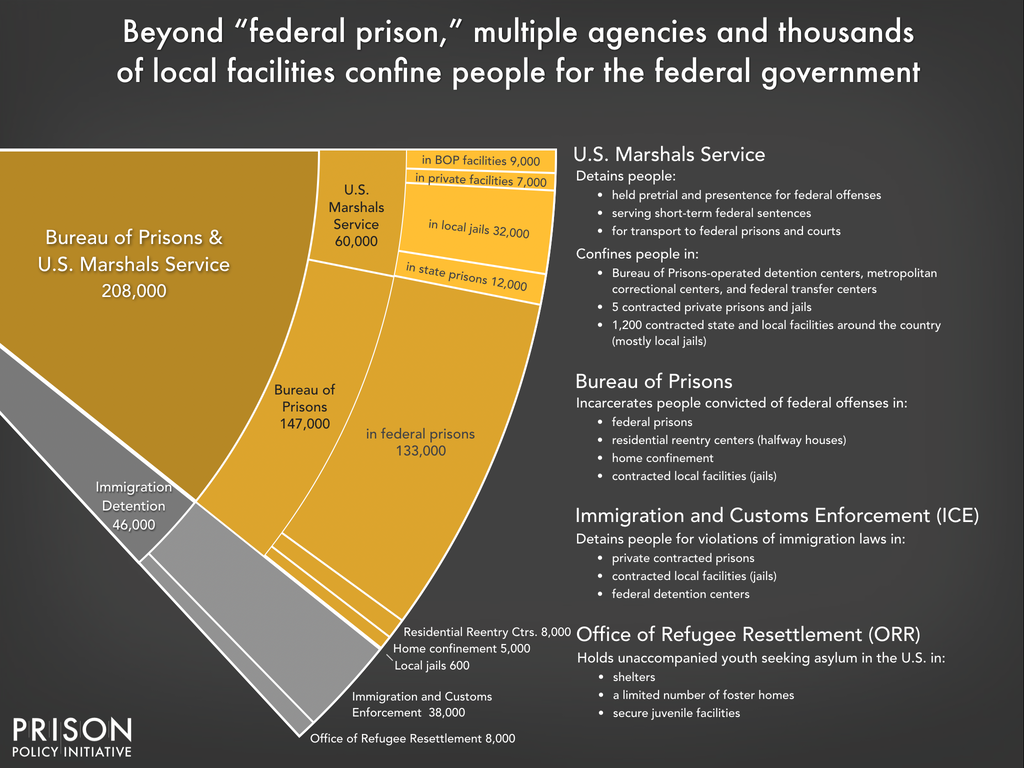
Slideshow 1. Swipe for more detailed views. For source dates and links, see the Methodology.




This big-picture view is a lens through which the main drivers of mass incarceration come into focus; 3 it allows us to identify important, but often ignored, systems of confinement, from immigration detention to involuntary commitment and youth confinement. In particular, local jails often receive short shrift in larger discussions about criminal legal system reform, but they play a critical role as “incarceration’s front door” and have a far greater impact than the daily population suggests.
They’ve got a lot in common, but they’re far from the same thing.
Prisons are facilities under state or federal control where people who have been convicted (usually of felonies) go to serve their sentences. Jails are city- or county-run facilities where a majority of people locked up are there awaiting trial (in other words, still legally innocent), many because they can’t afford to post bail. To make things a little more complicated, some people do serve their sentences in local jails, either because their sentences are short or because the jail is renting space to the state prison system.
While this pie chart provides a comprehensive snapshot of our correctional system, the graphic does not capture the enormous churn in and out of our correctional facilities, nor the far larger universe of people whose lives are affected by the criminal legal system. In 2022, about 469,000 people entered prison gates, but people went to jail more than 7 million times. 4 5 Some have just been arrested and will make bail within hours or days, while many others are too poor to make bail and remain in jail until their trial. 6 Only a small number (about 102,700 on any given day) have been convicted, and are generally serving misdemeanors sentences of under a year. At least 1 in 4 people who go to jail will be arrested again within the same year — often those dealing with poverty, mental illness, and substance use disorders, whose problems only worsen with incarceration.
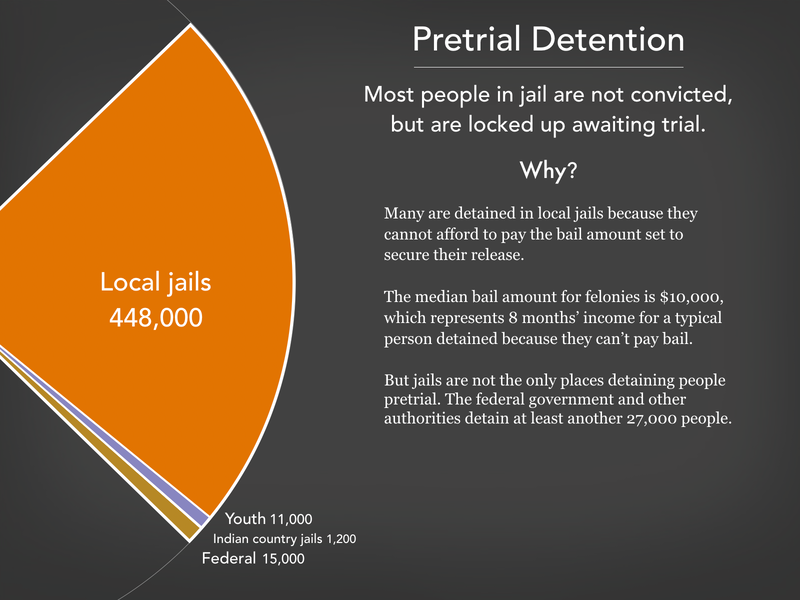
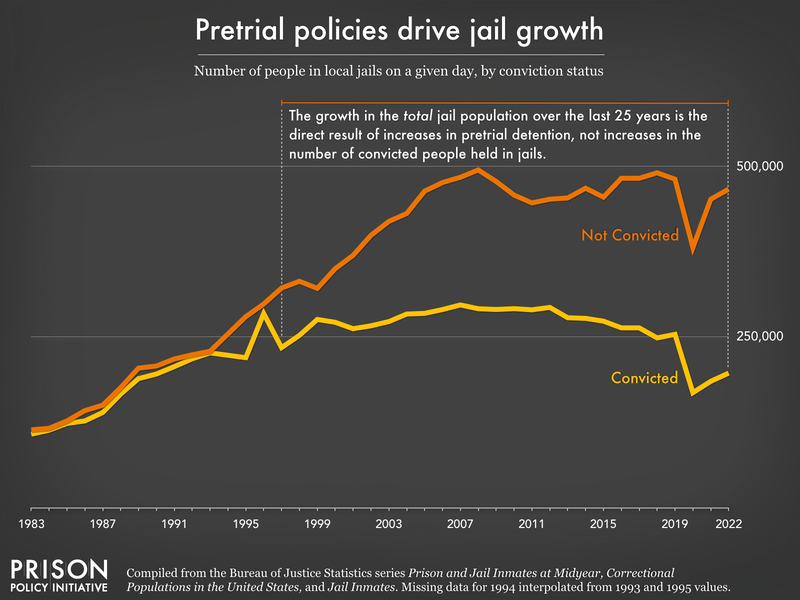 the cause is gradual changes in our pretrial policies to make detention prior to trial more common. " width="800" height="600" />
the cause is gradual changes in our pretrial policies to make detention prior to trial more common. " width="800" height="600" />
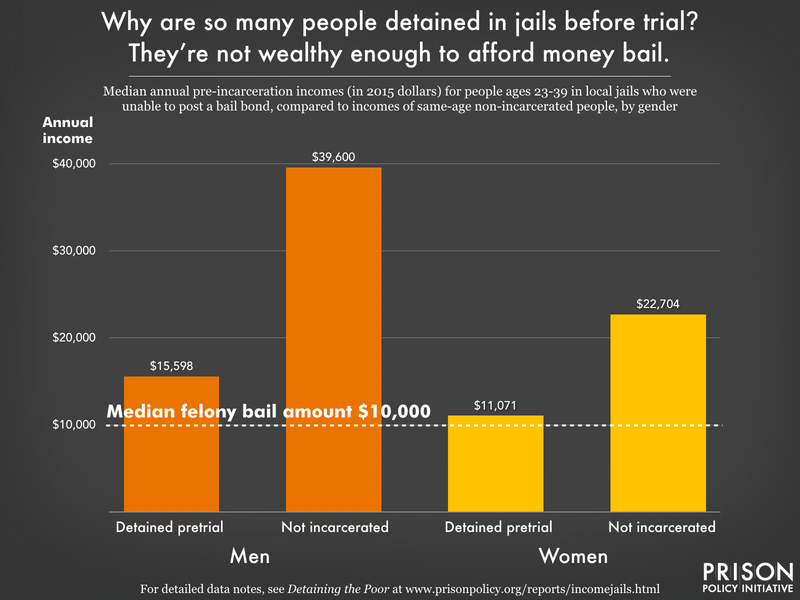

Slideshow 2. Swipe for more detail on pretrial detention.




With a sense of the big picture, the next question is: why are so many people locked up? How many are incarcerated for drug offenses? Are the profit motives of private companies driving incarceration? Or is it really about public safety and keeping dangerous people off the streets? There are a plethora of modern myths about incarceration. Most have a kernel of truth, but these myths distract us from focusing on the most important drivers of incarceration.
The overcriminalization of drug use, the use of private prisons, and low-paid or unpaid prison labor are among the most contentious issues in the criminal legal system today because they inspire moral outrage. But they do not answer the question of why most people are incarcerated or how we can dramatically — and safely — reduce our use of confinement. Likewise, emotional responses to sexual and violent offenses often derail important conversations about the social, economic, and moral costs of incarceration and lifelong punishment. False notions of what a “violent crime” conviction means about an individual’s dangerousness continue to be used in an attempt to justify long sentences — even though incarceration does not deter crime and more incarceration is not what victims want. At the same time, misguided beliefs about the “services” provided by jails are used to rationalize the construction of massive new “mental health jails.” Finally, simplistic solutions to reducing incarceration, such as moving people from jails and prisons to community supervision, ignore the fact that “alternatives” to incarceration often lead to incarceration anyway. Focusing on the policy changes that can end mass incarceration, and not just put a dent in it, requires the public to put these issues into perspective.
Reported offense data oversimplifies how people interact with the criminal legal system in two important ways.
To understand the main drivers of incarceration, the public needs to see how many people are incarcerated for different offense types. But the reported offense data oversimplifies how people interact with the criminal legal system in two important ways: it reports only one offense category per person, and it reflects the outcome of the legal process, obscuring important details of actual events.
First, when a person is in prison for multiple offenses, only the most serious offense is reported. 7 So, for example, there are people in prison for violent offenses who were also convicted of drug offenses, but they are included only in the “violent” category in the data. This makes it hard to grasp the complexity of criminal events, such as the role drugs may have played in violent or property offenses. We must also consider that almost all convictions are the result of plea bargains, where defendants plead guilty to a lesser offense, possibly in a different category or one that they did not actually commit, in exchange for a more lenient sentence.
Secondly, many of these categories group together people convicted of a wide range of offenses. For violent offenses especially, these labels can distort perceptions of individual “violent offenders” and exaggerate the scale of dangerous, violent crime. Even the seemingly clear-cut offense of “murder” is applied to a variety of situations and individuals: it lumps together the small number of serial killers with people who participated in acts that are unlikely to ever happen again, either due to circumstance or age. “Murder” also includes acts that the average person may not consider to be murder at all. In particular, the felony murder rule says that if someone dies during the commission of a felony, everyone involved can be as guilty of murder as the person who directly caused the death. Many may be surprised that a person who was acting as a lookout during a break-in where someone was accidentally killed can be convicted of murder. 8
In fact, just 8% of all incarcerated people are held in private prisons; the vast majority are in publicly-owned prisons and jails. 9 Some states have more people in private prisons than others, of course, and the industry has lobbied to maintain high levels of incarceration, but private prisons are essentially a parasite on the massive publicly-owned system — not the root of it.
Nevertheless, a range of private industries and even some public agencies continue to profit from mass incarceration. Many city and county jails rent space to other agencies, including state prison systems, 10 the U.S. Marshals Service, and Immigration and Customs Enforcement (ICE). Private companies are frequently granted contracts to operate prison food and health services (often so bad they result in major lawsuits), and prison and jail telecom and commissary functions have spawned multi-billion dollar private industries. By privatizing services like phone calls, medical care, and commissary, prisons and jails are offloading the costs of incarceration onto incarcerated people and their families, trimming their budgets at an unconscionable social cost.
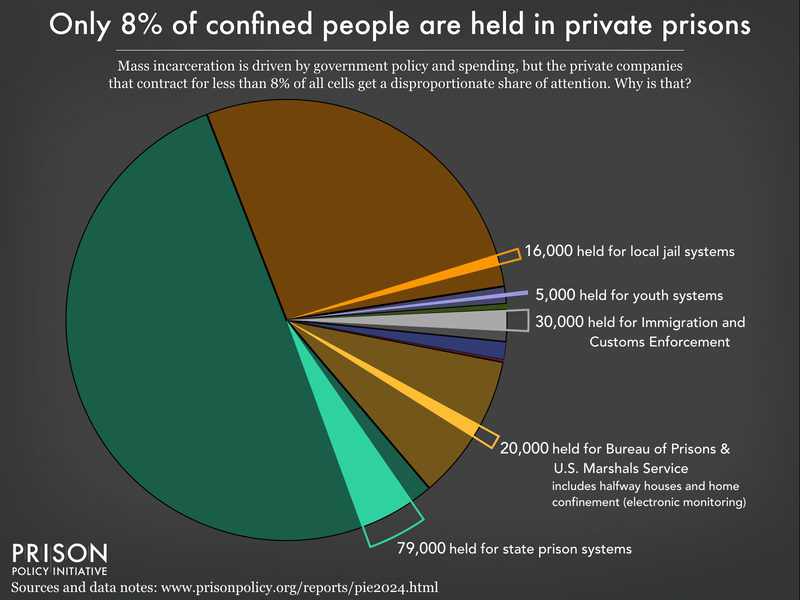
Private prisons and jails hold just 8% of all incarcerated people, making them a relatively small part of a mostly publicly-run correctional system.
Simply put, private companies using prison labor are not what stands in the way of ending mass incarceration, nor are they the source of most prison jobs. Only about 6,000 people in prison — less than 1% — are employed by private companies through the federal PIECP program, which requires them to pay at least minimum wage before deductions. (A larger portion work for state-owned “correctional industries,” which pay much less, but this still only represents about 6% of people incarcerated in state prisons.) 11
But prisons do rely on the labor of incarcerated people for food service, laundry, and other operations, and they pay incarcerated workers unconscionably low wages: our 2017 study found that on average, incarcerated people earn between 86 cents and $3.45 per day for the most common prison jobs. 12 In at least five states, those jobs pay nothing at all. Moreover, work in prison is compulsory, with little regulation or oversight, and incarcerated workers have few rights and protections. If they refuse to work, incarcerated people face disciplinary action. For those who do work, the paltry wages they receive often go right back to the prison, which charges them for basic necessities like medical visits and hygiene items. Forcing people to work for low or no pay and no benefits, while charging them for necessities, allows prisons to shift the costs of incarceration to incarcerated people — hiding the true cost of running prisons from most Americans.
It’s true that police, prosecutors, and judges continue to punish people harshly for nothing more than drug possession. Drug offenses still account for the incarceration of over 360,000 people, and drug convictions remain a defining feature of the federal prison system. And until the pandemic hit (and the official crime data became less reliable), police were still making over 1 million drug possession arrests each year, 13 many of which lead to prison sentences. Drug arrests continue to give residents of over-policed communities criminal records, hurting their employment prospects and increasing the likelihood of longer sentences for any future offenses.
Nevertheless, 4 out of 5 people in prison or jail are locked up for something other than a drug offense — either a more serious offense or an even less serious one. To end mass incarceration, we will have to change how our society and our criminal legal system respond to crimes more serious than drug possession. We must also stop incarcerating people for behaviors that are even more benign.
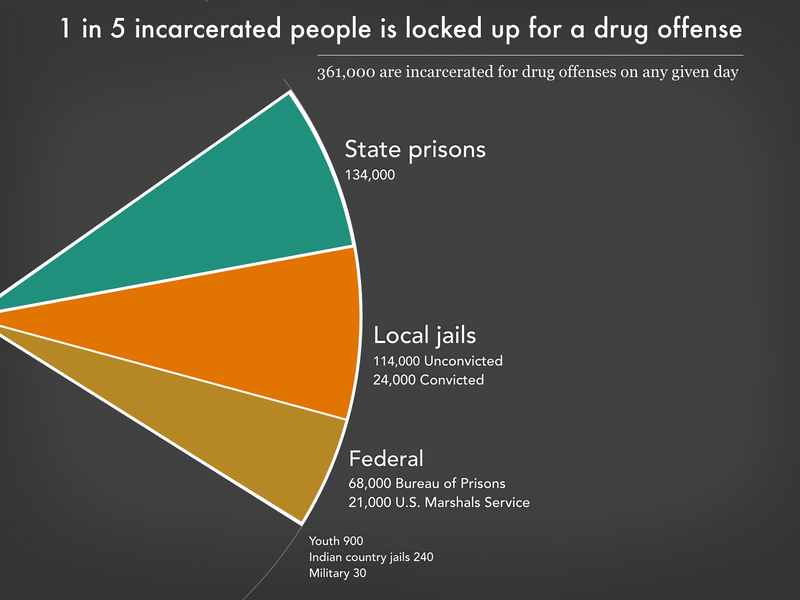
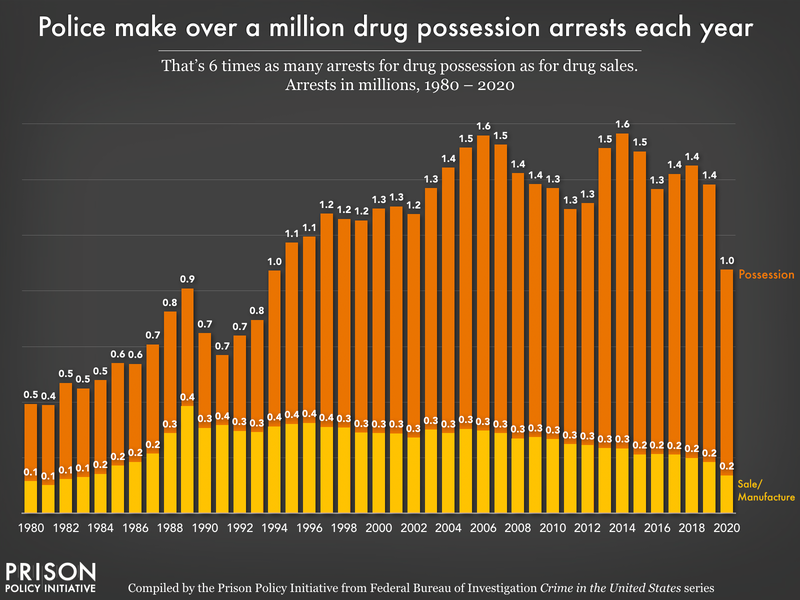
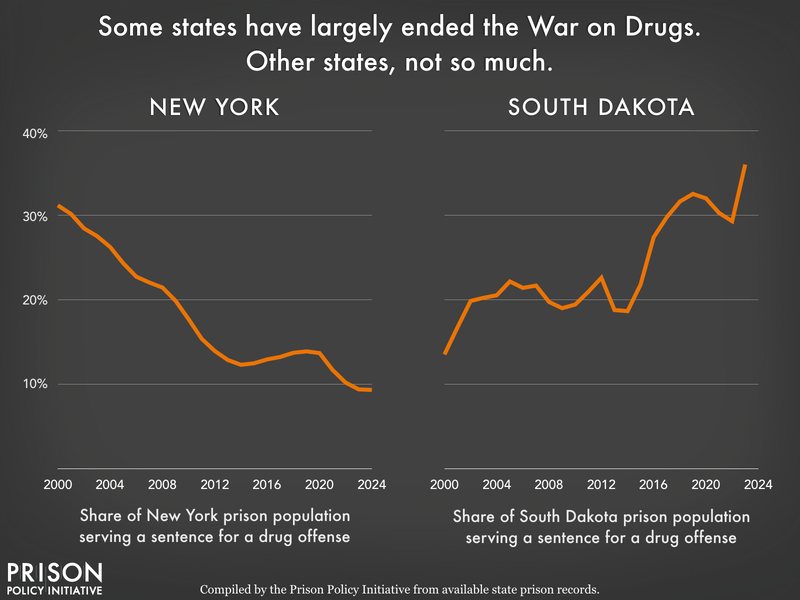
Slideshow 3. Swipe for more detail on the War on Drugs



The distinction between “violent” and “nonviolent” crime means less than you might think; in fact, these terms are so widely misused that they are generally unhelpful in a policy context. In the public discourse about crime, people typically use “violent” and “nonviolent” as substitutes for serious versus nonserious criminal acts. That alone is a fallacy, but worse, these terms are also used as coded (often racialized) language to label individuals as inherently dangerous versus non-dangerous.
In reality, state and federal laws apply the term “violent” to a surprisingly wide range of criminal acts — including many that don’t involve any physical harm. In some states, purse-snatching, manufacturing methamphetamines, and stealing drugs are considered violent crimes. Burglary is generally considered a property crime, but an array of state and federal laws classify burglary as a violent crime in certain situations, such as when it occurs at night, in a residence, or with a weapon present. So even if the building was unoccupied, someone convicted of burglary could be punished for a violent crime and end up with a long prison sentence and a “violent” record.
The common misunderstanding of what “violent crime” really refers to — a legal distinction that often has little to do with actual or intended harm — is one of the main barriers to meaningful criminal legal system reform. Reactionary responses to the idea of violent crime often lead policymakers to categorically exclude from reforms people convicted of legally “violent” crimes. But almost half (47%) of people in prison and jail are there for offenses classified as “violent,” so these carveouts end up gutting the impact of otherwise well-crafted policies. As we and many others have explained before, cutting incarceration rates to anything near international norms will be impossible without changing how we respond to violent crime. To start, we have to be clearer about what that loaded term really means.
Of course, many people convicted of violent offenses have caused serious harm to others. But how does the criminal legal system determine the risk that they pose to their communities? Again, the answer is too often “we judge them by their offense type,” rather than “we evaluate their individual circumstances.” This reflects the particularly harmful myth that people who commit violent or sexual crimes are incapable of rehabilitation and thus warrant many decades or even a lifetime of punishment.
As lawmakers and the public increasingly agree that past policies have led to unnecessary incarceration, it’s time to consider policy changes that go beyond the low-hanging fruit of “non-non-nons” — people convicted of non-violent, non-serious, non-sexual offenses. Again, if we are serious about ending mass incarceration, we will have to change our responses to more serious and violent crime.
How well do different measures of recidivism reflect actual failure or success upon reentry?
As long as we are considering recidivism rates as a measure of public safety risk, we should also consider how recidivism is defined and measured. While this may sound esoteric, this is an issue that affects an important policy question: at what point — and with what measure — do we consider someone’s reentry a success or failure?
The term “recidivism” suggests a relapse in behavior, a return to criminal offending. But what is a valid sign of criminal offending: self-reported behavior, arrest, conviction, or incarceration? Defining recidivism as rearrest casts the widest net and results in the highest rates, but arrest does not suggest conviction, nor actual guilt. More useful measures than rearrest include conviction for a new crime, re-incarceration, or a new sentence of imprisonment; the latter may be most relevant, since it measures offenses serious enough to warrant a prison sentence. Importantly, people convicted of violent offenses have the lowest recidivism rates by each of these measures. However, the recidivism rate for violent offenses is a whopping 48 percentage points higher when rearrest, rather than imprisonment, is used to define recidivism.
The cutoff point at which recidivism is measured also matters: If someone is arrested for the first time 5, 10, or 20 years after they leave prison, that’s very different from someone arrested within months of release. The most recent government study of recidivism reported that 82% of people incarcerated in state prison were arrested at some point in the 10 years following their release. However, the vast majority of people in this group were arrested within the first three years, and more than half within the first year. The longer the time period, the higher the reported recidivism rate — but the lower the actual threat to public safety.
A related question is whether the particular post-release offense matters. For example, 69% of people imprisoned for a violent offense are rearrested within five years of release, but only 44% are rearrested for another violent offense; they are much more likely to be rearrested for a public order offense. If someone convicted of robbery is arrested years later for a liquor law violation, it makes no sense to view this very different, much less serious, offense the same way we would another arrest for robbery. Moreover, public order offenses often include “technical” violations, so in many states, recidivism statistics are inflated by these non-criminal infractions.
A final note about recidivism: While policymakers frequently cite reducing recidivism as a priority, few states collect the data that would allow them to monitor and improve their own performance in real time. For example, the Council of State Governments asked correctional systems what kind of recidivism data they collect and publish for people leaving prison and people starting probation. What they found is that states typically track just one measure of post-release recidivism, and few states track recidivism while on probation at all:


If state-level advocates and political leaders want to know if their state is even trying to reduce recidivism, we suggest one easy litmus test: Do they collect and publish basic data about the number and causes of people’s interactions with the justice system while on probation, or after release from prison?
Recidivism data do not support the belief that people who commit violent crimes ought to be locked away for decades for the sake of public safety. People convicted of violent and sexual offenses are actually among the least likely to be rearrested, and those convicted of rape or sexual assault have rearrest rates 20% lower than all other offense categories combined. One reason for the lower rates of recidivism among people convicted of violent offenses: age is one of the main predictors of violence. The risk for violence peaks in adolescence or early adulthood and then declines with age, yet we incarcerate people long after their risk has declined. 14
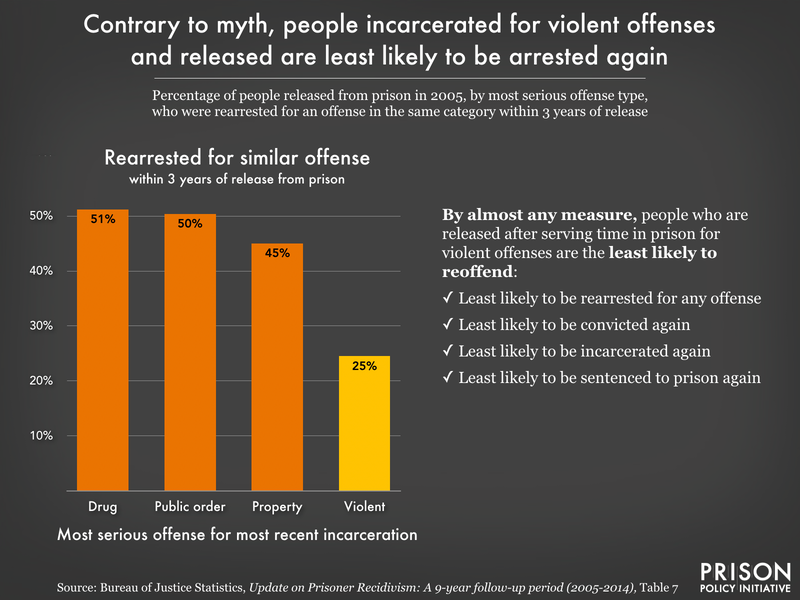
The specter of “rising crime” has re-emerged as a central issue among elected officials, political candidates, and in media commentary. Their explanations and exaggerations of recent crime trends don’t add up, but these lies have serious consequences. After ticking up slightly in 2020, the violent crime rate appears to have fallen dramatically in 2023. In general, violent crime has remained remarkably steady over the last 15 years; property crime has trended steeply downward and remains near historic lows (with the exception of auto theft). Overall, the crime rate appears to be the lowest it’s been since 1963. 15
Jail and prison populations have continued to rebound toward their pre-pandemic levels — not because of rising crime, but because pandemic-related delays in the system have subsided. 16 Politics present another important explanation: many in law enforcement and on the right (and some Democrats, too) have rushed to blame recent reforms for minor shifts in crime trends in an effort to resurrect the same “tough on crime” policies that failed in the 1980s and 90s. The combination of restored court capacity and the return to 90s-era crime policies crime policies — not COVID-era releases, 17 bail reform, changes to police budgets, “progressive” prosecutors, or other popular reforms — best explain why more people are behind bars this year than last. In reality, a number of studies have shown:
While crime rates remain near historic lows, what has actually changed most is the public’s perception of crime, which is driven less by first-hand experience than by the false claims of reform opponents. These false claims are deliberately stoked to undo the hard-won, evidence supported, common sense reforms that have only begun to put a dent in mass incarceration.
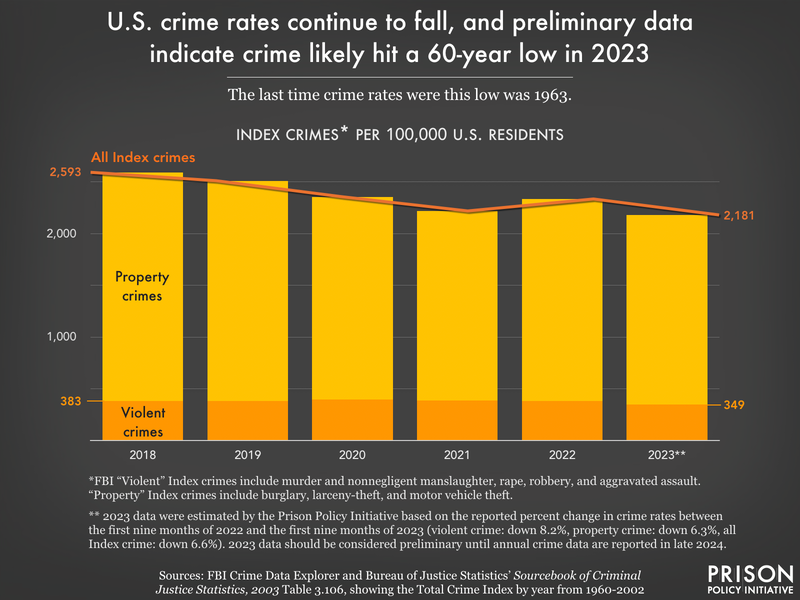
Many people mistakenly believe that long sentences, paired with austere and even brutal prison conditions, will have a deterrent effect on crime. But research has consistently found that harsher sentences do not serve as effective “examples” that would prevent new people from committing serious crimes. In 2016, the National Institute of Justice summarized the research on deterrence, finding that prison sentences, and especially long sentences, do little to deter future crime. 19 Another study concluded that, compared to punishments that don’t involve prison or jail time, incarceration has either no effect or — worse — even a “mildly criminogenic impact” on future lawbreaking. In other words, incarceration is counterproductive: While a prison sentence can incapacitate people in the short term, it actually increases the risk that someone will commit a crime after their release.
People face extremely poor living conditions in practically every jail and prison, which negatively impacts their odds of success upon release, their families, and public health at large. Routine failure to provide for the medical needs of incarcerated people is harmful (even deadly) for those inside, and strains family resources and healthcare infrastructure after they’re released — and nearly everyone will eventually be released. Poor nutrition compounds health problems, as does contaminated water, pests, and exposure to extreme heat and cold. The physical and psychological effects of incarceration, including the PTSD-like Post-Incarceration Syndrome, make it harder to maintain employment and housing, trapping people in cycles of incarceration. Put simply, when people are released from prison, their health and wellbeing are intertwined with that of the community, so the harms visited upon them inside impact everyone.
Policymakers, judges, and prosecutors often invoke the name of victims to justify long sentences for violent offenses. But contrary to the popular narrative, most victims of violence want violence prevention, not incarceration. Again, harsh sentences don’t deter violent crime, and many victims understand that incarceration can make people more of a public safety risk. National survey data show that most victims support violence prevention, social investment, and alternatives to incarceration that address the root causes of crime, not more investment in carceral systems that cause more harm. 20 This suggests that they care more about the health and safety of their communities than they do about retribution.
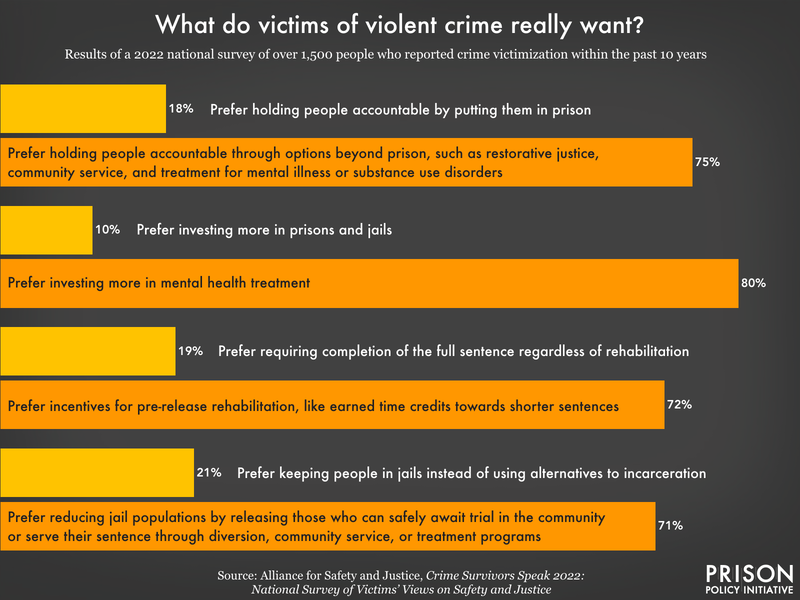
Victims and survivors of crime prefer investments in crime prevention rather than long prison sentences.
Moreover, people convicted of crimes are often victims themselves, complicating the moral argument for harsh punishments as “justice.” While conversations about justice tend to treat perpetrators and victims of crime as two entirely separate groups, people who engage in criminal acts are often victims of violence and trauma, too — a fact behind the adage that “hurt people hurt people.” 21 As victims of crime know, breaking this cycle of harm will require greater investments in communities, not the carceral system.
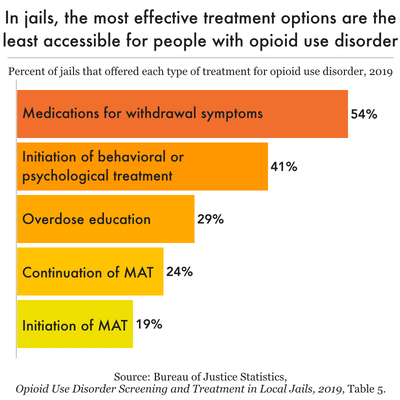
It’s absolutely true that people ensnared in the criminal legal system have a lot of unmet needs. But jails and prisons are no place to recover from a mental health crisis or substance use disorder — they are designed for punishment, not care. Local jails, especially, are filled with people who need medical care and social services, but jails have repeatedly failed to provide these services. For example, while two-thirds of people in local jails have substance use disorders, only a tiny fraction of all jails provide medication-assisted treatment (MAT) for opioid use disorder — the gold standard for care. That means that rather than providing drug treatment, jails more often interrupt drug treatment by cutting patients off from their medications. Between 2000 and 2018, the number of people who died of intoxication while in jail increased by almost 400%; typically, these individuals died within just one day of admission. 22
Similarly, jails often put people with mental health problems in solitary confinement, provide limited access to counseling, and leave them unmonitored due to constant staffing shortages. The result: suicide is the leading cause of death in local jails, with death rates far exceeding those found in the general U.S. population. Given this track record, the trend of proposing new “mental health jails” to respond to decades of disinvestment in community-based services is particularly alarming. Jails are not safe detox facilities, nor are they capable of providing the therapeutic environment people require for long-term recovery and healing. Even when other options for providing mental health and substance use treatment are scarce, decisionmakers should not rely on correctional settings to do so.
Community supervision, which includes probation, parole, and pretrial supervision, is often seen as a “lenient” punishment or as an ideal “alternative” to incarceration. But while remaining in the community is generally preferable to being locked up, the conditions 23 imposed on those under supervision are often so restrictive that they set people up to fail. 24 The long supervision terms, numerous and burdensome requirements, and constant surveillance result in frequent “failures,” often for minor infractions like breaking curfew or failing to pay unaffordable supervision fees.
At last count, at least 128,000 people were incarcerated for such non-criminal “technical violations” of probation or parole. 25 These supervision violations accounted for 27% of all admissions to state and federal prisons. In fact, the Bureau of Justice Statistics found that almost a quarter (24%) of people in state prisons were on probation at the time of their arrest, underscoring how this “alternative to incarceration” often simply delays incarceration.
Newer methods of community supervision don’t simply delay incarceration; they replicate the experience so closely through the use of technology that they amount to “e-carceration” or “electronic prisons.” 26 The use of electronic monitoring, in particular — whether via ankle shackle, phone app, or other technology — has exploded in recent years, especially in the contexts of pretrial supervision and immigration enforcement. 27 Proponents argue the technology improves court compliance and public safety, but a recent study found the practice accomplishes neither of these goals. The technology is unreliable, frequently leading to security breaches and false alarms, and it has created yet another path to incarceration via technical violations. 28 Like probation before it, electronic monitoring is touted as an “alternative” to incarceration, but in reality it is expanding the scope of correctional control, not reducing the number of people behind bars.
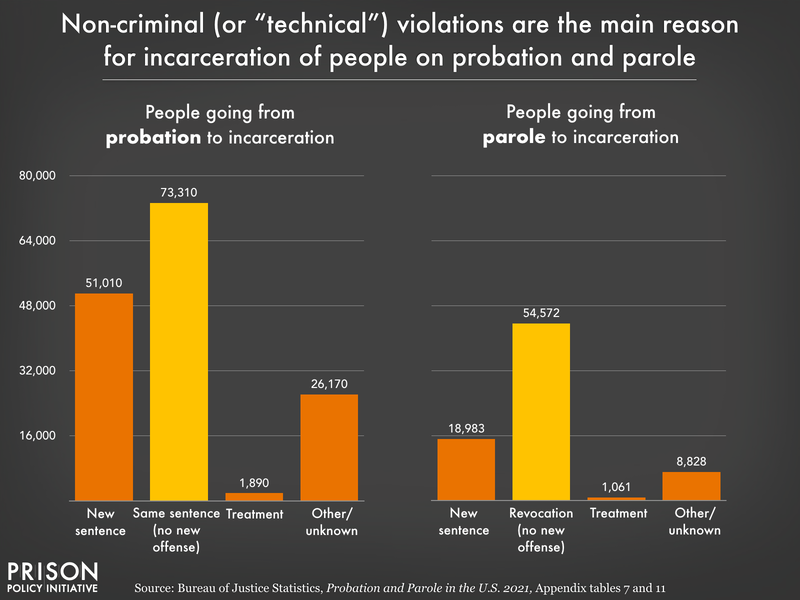
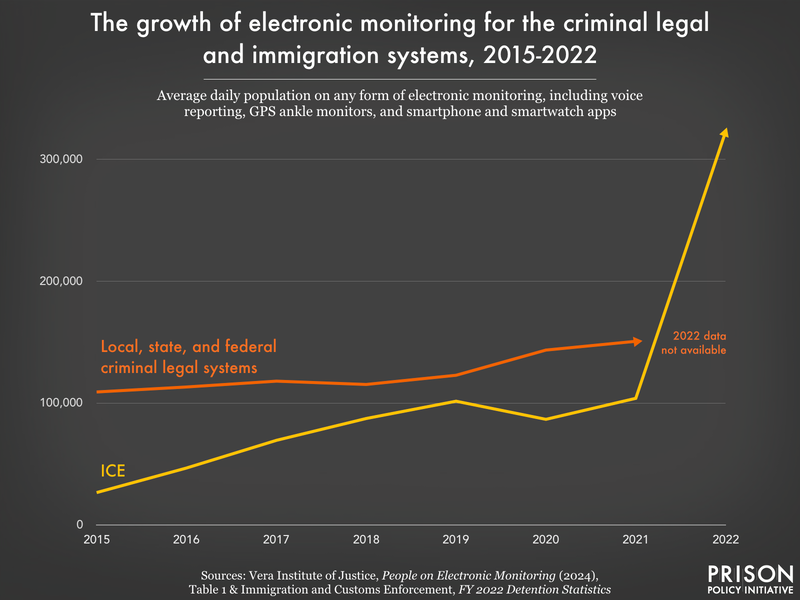
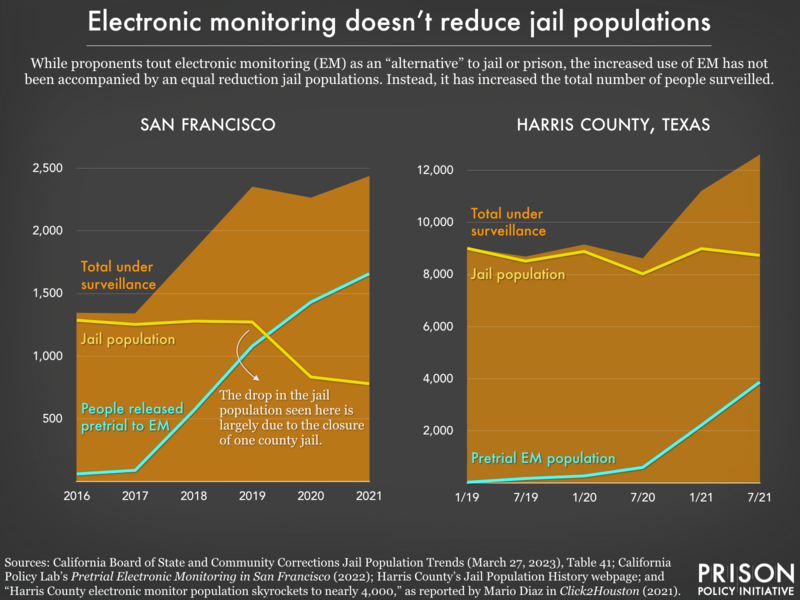
Slideshow 4. Swipe for more details about how community supervision and electronic monitoring can lead to more incarceration.



Most people in the U.S. criminal legal system are not accused of serious crimes; more often, they are charged with misdemeanors or non-criminal violations. Yet even low-level offenses, like technical violations of probation and parole, can lead to incarceration and other serious consequences. Rather than investing in community-driven safety initiatives, cities and counties are still pouring vast amounts of public resources into the processing and punishment of these minor offenses.
Often overlooked in discussions about mass incarceration are the various “holds” that keep people behind bars for administrative reasons. A common example is when people on probation or parole are jailed for violating their supervision, either for a new crime or a non-criminal (or “technical”) violation. If a parole or probation officer suspects that someone has violated supervision conditions, they can file a “detainer” (or “hold”), rendering that person ineligible for release on bail. For people struggling to rebuild their lives after conviction or incarceration, returning to jail for a minor infraction can be profoundly destabilizing. The most recent data show that nationally, almost 1 in 5 (19%) people in jail are there for a violation of probation or parole, though in some places these violations or detainers account for over one-third of the jail population. This problem is not limited to local jails, either; in 2019, the Council of State Governments found that nearly 1 in 4 people in state prisons are incarcerated as a result of supervision violations.
A particularly disturbing type of “hold” is becoming increasingly common: people held in jails while awaiting transfer to psychiatric facilities. One recent study reports that “thousands of [people] with serious mental illness languish in jail for months, or even years, waiting for a state hospital bed to open.” 29 Typically, these vulnerable adults are in need of evaluation or restoration of their competency to stand trial. But being held in jails puts them at heightened risk of victimization, self-harm, and even additional criminal charges for behaviors that are actually symptoms of their illness. The result of disinvestment in mental health infrastructure and the criminalization of mental illness, these “holds” are not only unnecessary, but unconscionable.
The “massive misdemeanor system” in the U.S. is another important but overlooked contributor to overcriminalization and mass incarceration. For behaviors as benign as jaywalking or sitting on a sidewalk, an estimated 13 million misdemeanor charges sweep droves of Americans into the criminal legal system each year (and that’s excluding civil violations and speeding). These low-level offenses, along with other non-felony offenses, typically account for about 25% of the daily jail population nationally, and much more in some states and counties. The rampant criminalization of homelessness and aggressive enforcement of these laws — almost all misdemeanors — also contributes to harmful and costly cycles of homelessness and incarceration.
Misdemeanor charges may sound trivial, but they carry serious financial, personal, and social costs, especially for defendants but also for broader society, which finances the processing of these court cases and all of the unnecessary incarceration that comes with them. And then there are the moral costs: People charged with misdemeanors are often not appointed counsel and are pressured to plead guilty and accept a probation sentence to avoid jail time. This means that innocent people routinely plead guilty and are then burdened with the many collateral consequences that come with a criminal record, as well as the heightened risk of future incarceration for probation violations. A misdemeanor system that pressures innocent defendants to plead guilty seriously undermines American principles of justice.
Defendants can end up in jail even if their offense is not punishable with jail time. Why? Because if a defendant fails to appear in court or to pay fines and fees, the judge can issue a “bench warrant” for their arrest, directing law enforcement to jail them in order to bring them to court. While there is currently no national estimate of the number of active bench warrants, their use is widespread and, in some places, incredibly common. In Monroe County, N.Y., for example, over 3,000 people have an active bench warrant at any time, more than 3 times the number of people in the county jails.
But bench warrants are often unnecessary. Most people who miss court are not trying to avoid the law; more often, they forget, are confused by the court process, or have a schedule conflict. Once a bench warrant is issued, however, defendants frequently end up living as “low-level fugitives,” quitting their jobs, becoming transient, and/or avoiding public life (even hospitals) to avoid having to go to jail.
Looking more closely at incarceration by offense type also exposes some disturbing facts about the 35,500 youth in confinement in the United States: too many are there for a “most serious offense” that is not even a crime. For example, there are 2,700 youth behind bars for non-criminal violations of their probation rather than for a new offense. An additional 700 youth are locked up for “status” offenses, which are “behaviors that are not law violations for adults such as running away, truancy, and incorrigibility.” 30 About 1 in 11 youth held for a criminal or delinquent offense is locked in an adult jail or prison, and most of the others are held in juvenile facilities that look and operate a lot like prisons and jails.
We also know that for many children, legal system involvement overlaps with other kinds of “systems” involvement, such as the foster care system: almost half of youth in foster care have an encounter with the criminal legal system by age 17. The criminalization of youth is apparent in the adult prison population: more than one-third (38%) of people in state prisons were first arrested before they turned 16.The early criminalization of youth is apparent in the adult prison population: more than one-third (38%) of people in state prisons were first arrested before they turned 16.
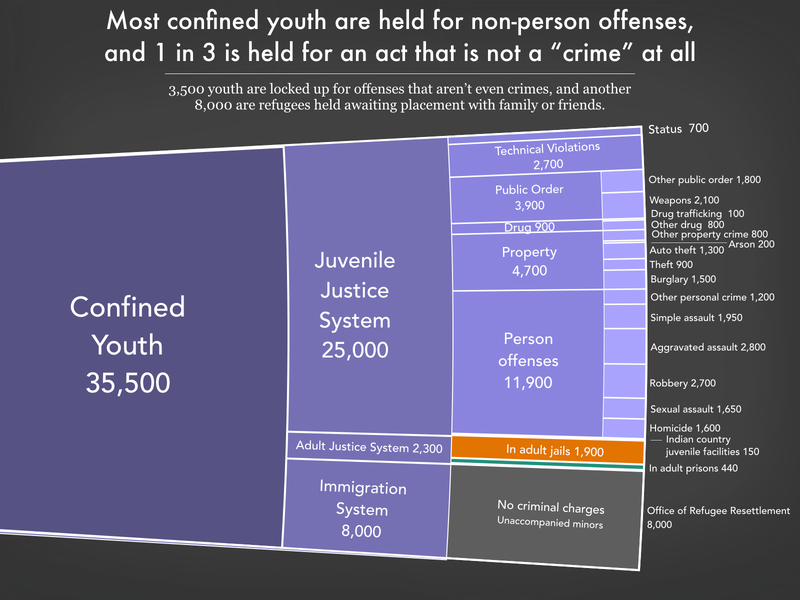
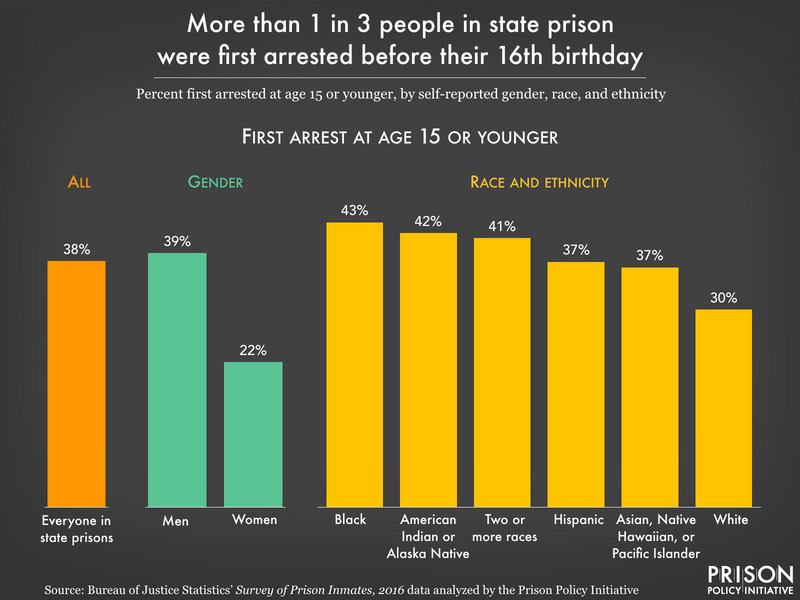
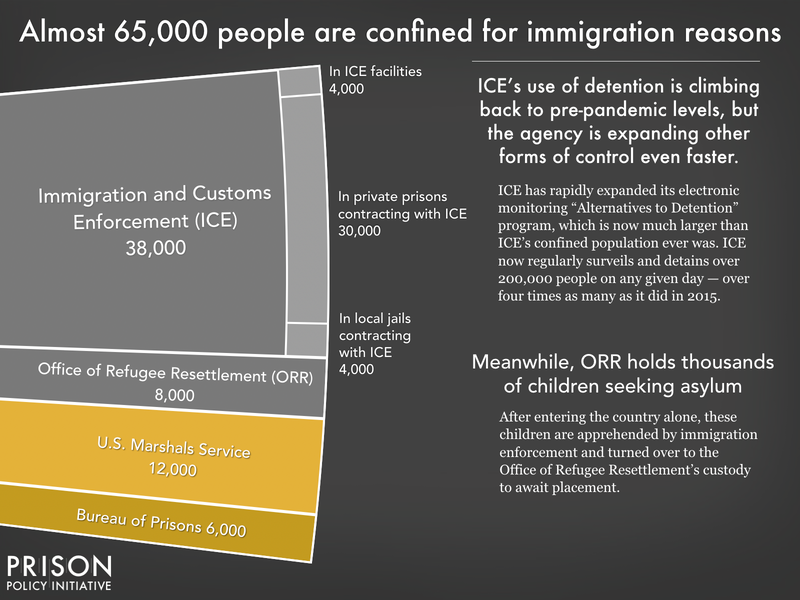
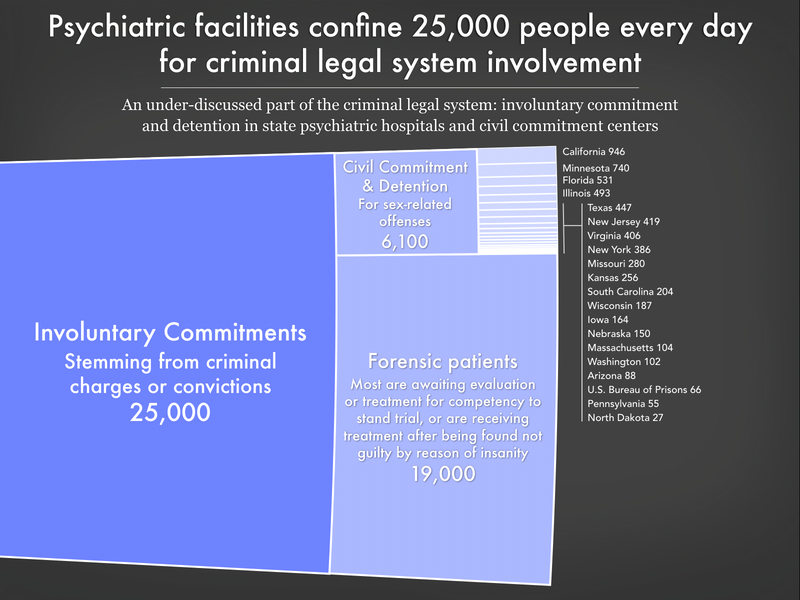 are being treated or evaluated as incompetent to stand trial(19,000). Graph is based on the newest data available in March 2024." width="800" height="600" />
are being treated or evaluated as incompetent to stand trial(19,000). Graph is based on the newest data available in March 2024." width="800" height="600" />
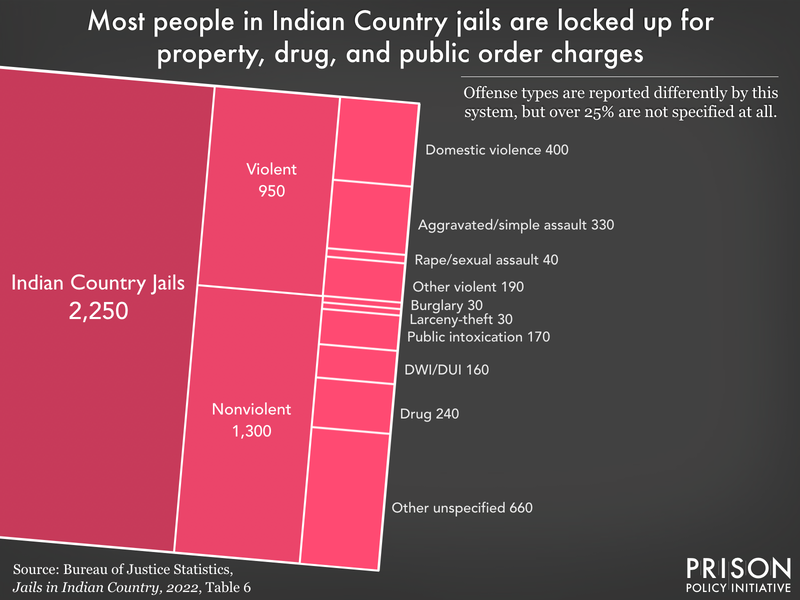
Slideshow 5. Swipe for more detail about youth confinement, immigrant confinement, and psychiatric confinement.





Turning to the people who are locked up criminally and civilly for immigration-related reasons, we find that over 6,000 people are in federal prisons for criminal convictions of immigration offenses, and 12,400 more are held pretrial or presentence by the U.S. Marshals Service. The vast majority of people incarcerated for criminal immigration offenses are accused of illegal entry or illegal reentry — in other words, for no more serious offense than crossing the border without permission. 31
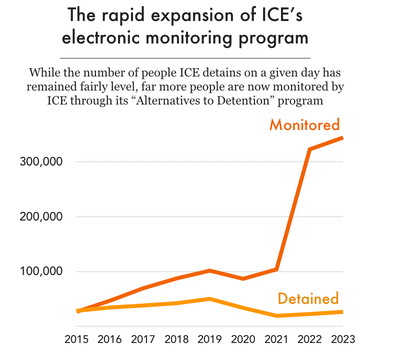
Another 38,000 people are civilly detained by U.S. Immigration and Customs Enforcement (ICE) not for any crime, but simply because they are facing deportation. 32 People detained by ICE are physically confined in federally-run or privately-run immigration detention facilities, or in local jails under contract with ICE. While this number is below what it was pre-pandemic, it’s actually climbed back up from a record low of 13,500 people in ICE detention in early 2021. 33 In fact, ICE is very rapidly expanding its overall surveillance and control over the non-criminal migrant population by growing its electronic monitoring-based “alternatives to detention” program. 34
An additional 8,000 unaccompanied children are held in the custody of the Office of Refugee Resettlement (ORR), awaiting placement with parents, family members, or friends. Their number has more than doubled since January of 2020. While these children are not held for any criminal or delinquent offense, most are held in shelters or even juvenile placement facilities under detention-like conditions. 35
Adding to the universe of people who are confined because of criminal legal system involvement, 25,000 people are involuntarily committed in state psychiatric hospitals and civil commitment centers. 36 37 Many of these people are not even convicted, and some are held indefinitely. These “forensic patients” include people being evaluated or treated for incompetency to stand trial, as well as those found not guilty by reason of insanity or guilty but mentally ill, who may remain hospitalized for decades or for life. 38 Roughly 6,000 are people convicted of sex-related crimes who are involuntarily committed or detained after their prison sentences are complete. While the facilities they are held in aren’t typically run by departments of correction, they are in reality much like prisons. Meanwhile, at least 38 states allow involuntary commitment for substance use disorder treatment, and in many cases, people are sent to actual prisons and jails, which are inappropriate places for treatment. 39
Once we have wrapped our minds around the “whole pie” of mass incarceration, we should zoom out and note that people who are incarcerated are only a fraction of those impacted by the criminal legal system. There are another 800,000 people on parole and a staggering 2.9 million people on probation. Many millions more have completed their sentences but are still living with a criminal record, a stigmatizing label that comes with collateral consequences such as barriers to employment and housing.
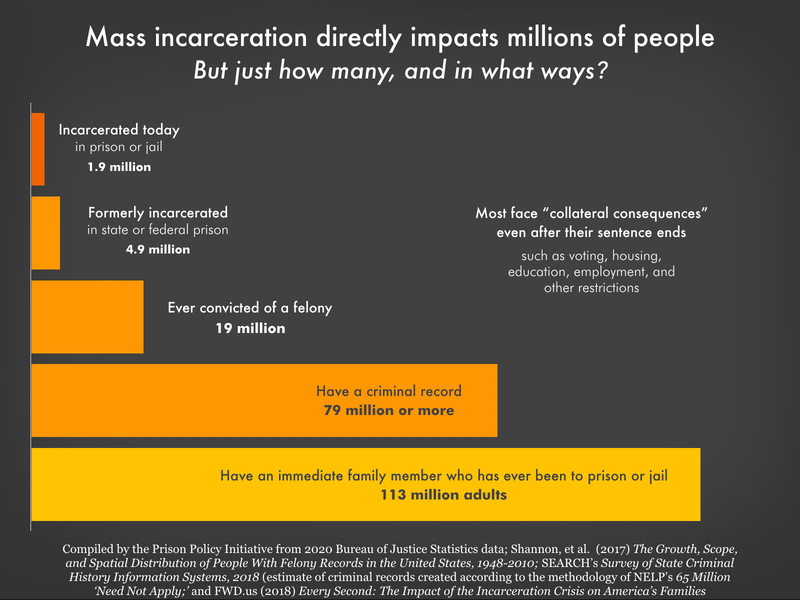
Far more people are impacted by mass incarceration than the 1.9 million currently confined. An estimated 19 million people are burdened with the collateral consequences of a felony conviction (this includes those currently and formerly incarcerated), and an estimated 79 million have a criminal record of some kind; even this is likely an underestimate, leaving out many people who have been arrested for misdemeanors. Finally, FWD.us reports that 113 million adults (45%) have had an immediate family member incarcerated for at least one night.
Beyond identifying how many people are impacted by the criminal legal system, we should also focus on who is most impacted and who is left behind by policy change. Poverty, for example, plays a central role in mass incarceration. People in prison and jail are disproportionately poor compared to the overall U.S. population. 40 The criminal legal system punishes poverty, beginning with the high price of money bail: The median felony bail bond amount ($10,000) is the equivalent of 8 months’ income for the typical detained defendant. As a result, people with low incomes are more likely to face the harms of pretrial detention. Poverty is not only a predictor of incarceration; it is also frequently the outcome, as a criminal record and time spent in prison destroys wealth, creates debt, initiates or perpetuates cycles of homelessness, and decimates job opportunities. 41
It’s no surprise that people of color — who face much greater rates of poverty — are dramatically overrepresented in the nation’s prisons and jails. These racial disparities are particularly stark for Black Americans, who make up 35% of the prison and jail populations but only 14% of all U.S residents. 42 The same is true for women, whose incarceration rates have for decades risen faster than men’s, and who are often behind bars because of financial obstacles such as an inability to pay bail. As policymakers continue to push for reforms that reduce incarceration, they should avoid changes that will widen disparities, as has happened with juvenile confinement and with women in state prisons.
Finally, while states have made progress in reducing youth confinement — due to developments in adolescent brain research, mounting evidence that confinement leads to worse outcomes, and dogged advocacy to protect youth — the elder population in prison has only grown. Many are stuck serving excessively long sentences, despite the evidence that their incarceration is both extremely costly and unnecessary to ensure public safety.
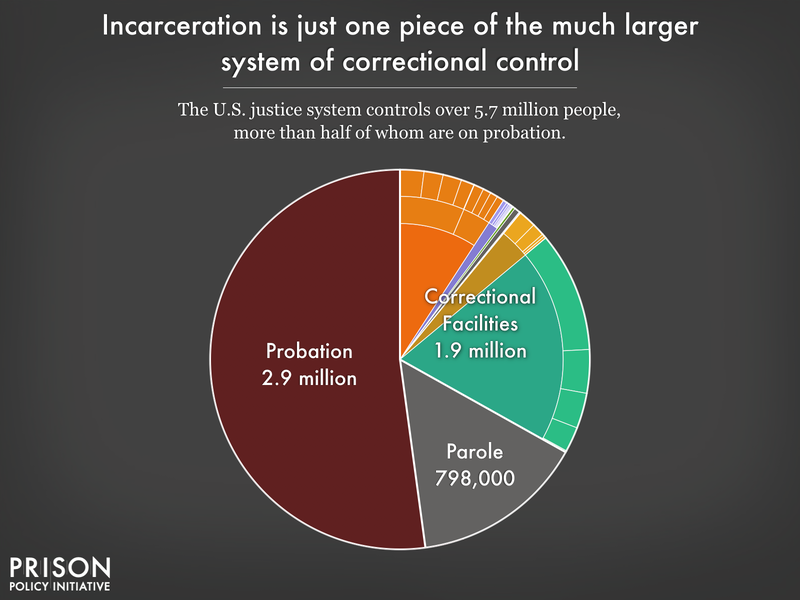
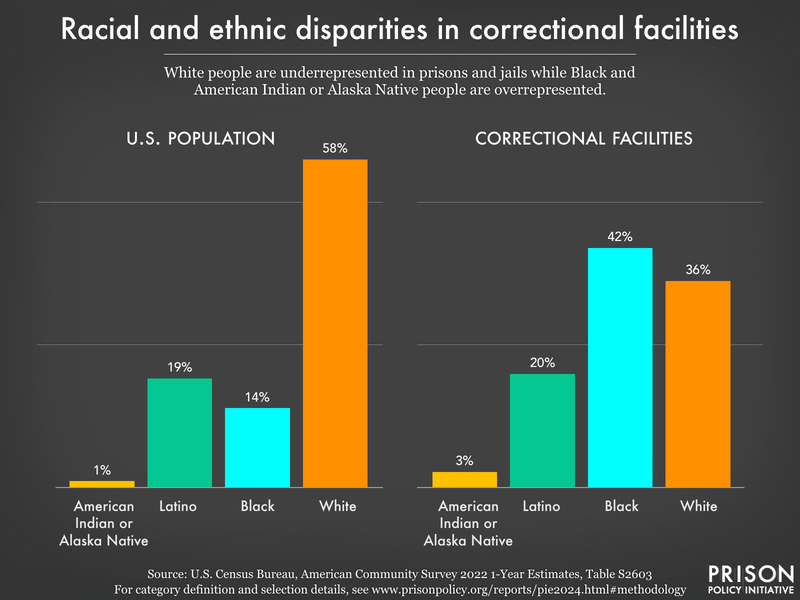
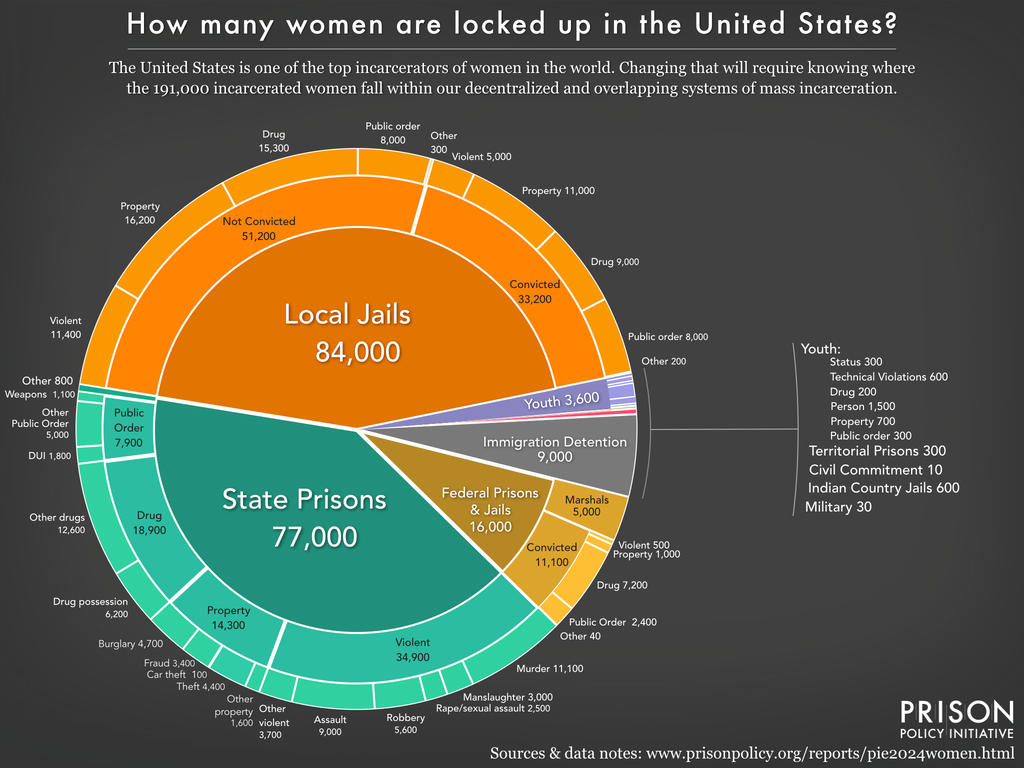
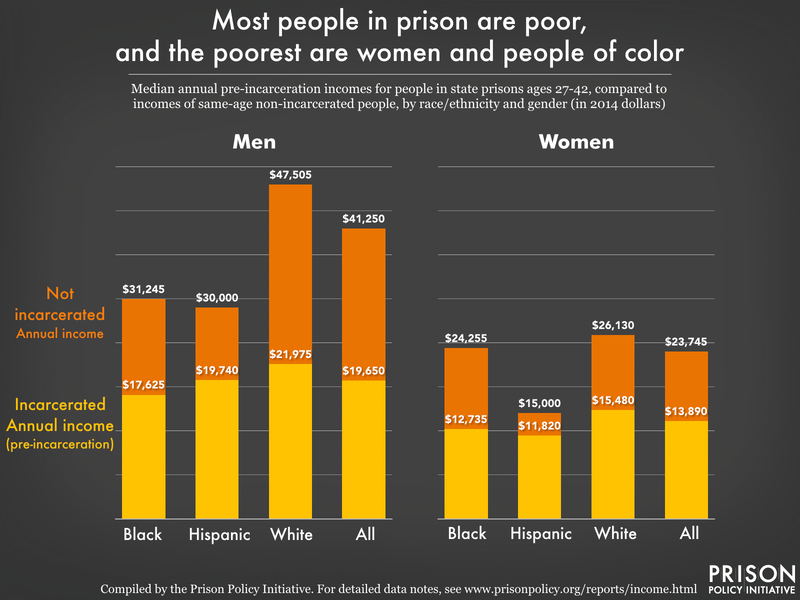
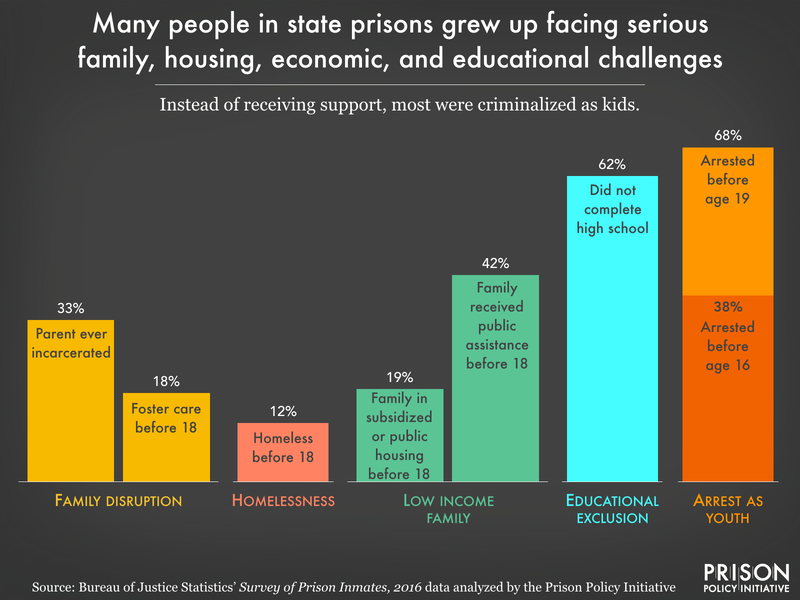
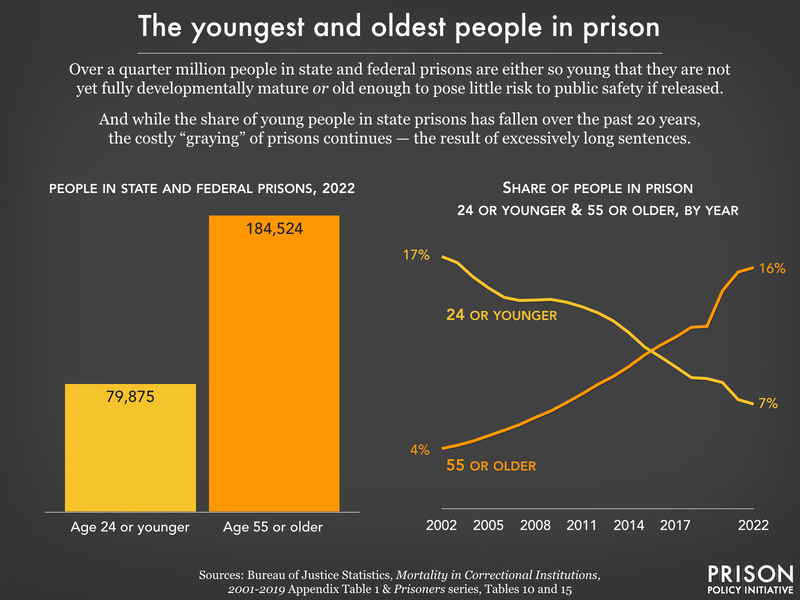
Slideshow 6. Swipe for more detail about race, gender, and income disparities.






Equipped with the full picture of how many people are locked up in the United States, where, and why, we all have a better foundation for moving the conversation about criminal legal system reform forward. For example, the data make it clear that ending the war on drugs will not alone end mass incarceration, though the federal government and some states have taken an important step by reducing the number of people incarcerated for drug offenses. Looking at the “whole pie” of mass incarceration opens up conversations about where it makes sense to focus our energies at the local, state, and national levels. For example:
The United States has the dubious distinction of having the highest incarceration rate of virtually any democratic nation on earth. Looking at the big picture of the 1.9 million people locked up in the United States on any given day, we can see that something needs to change. Both policymakers and the public have the responsibility to carefully consider each individual slice of the carceral “pie” and ask whether legitimate social goals are served by putting each group behind bars, and whether any benefit really outweighs the social and fiscal costs.
Even narrow policy changes, such as ending incarceration for “technical” violations, can meaningfully reduce our society’s use of incarceration. At the same time, we should be wary of proposed reforms that seem promising but will have only minimal effect, because they simply transfer people from one slice of the correctional “pie” to another or needlessly exclude broad swaths of people. Keeping the big picture in mind is critical if we hope to develop strategies that actually shrink the “whole pie.”
This section covers a lot of ground, from why we attempt to piece together the data ourselves in the first place to where we source the data and how we adjust it to make the various pieces fit together. Read on to learn:
People new to criminal legal issues might reasonably expect that a big picture analysis like this would be produced not by advocates, but by the criminal legal system itself. The unfortunate reality is that there isn’t one centralized system to do such an analysis. Instead, even thinking just about adult corrections, we have a federal system, 50 state systems, 3,000+ county systems, 25,000+ municipal systems, and so on. Each of these systems collects data for its own purposes that may or may not be compatible with data from other systems and that might duplicate or omit people counted by other systems
This isn’t to discount the work of the Bureau of Justice Statistics, which, despite limited resources, undertakes the Herculean task of organizing and standardizing the data on correctional facilities. And it’s not to say that the FBI doesn’t work hard to aggregate and standardize police arrest and crime report data. But the fact is that the local, state, and federal agencies that carry out the work of the criminal legal system — and are the sources of BJS and FBI data — weren’t set up to answer many of the simple-sounding questions about the “system.”
Similarly, there are systems of confinement that might not consider themselves part of the criminal legal system, but should be included in a holistic view of incarceration. Juvenile justice, immigration detention, civil commitment of people with sex-related convictions, and involuntary commitment to psychiatric hospitals for criminal legal system involvement are examples of this broader universe of confinement that is often ignored. The “whole pie” incorporates data from these systems to provide the most comprehensive view of incarceration possible.
To produce this report, we took the most recent data available for each part of these systems, and, where necessary, adjusted the data to ensure that each person was only counted once, only once, and in the right place. ⤴
This report uses the most recent data available on the number of people in various types of facilities and the most significant charge or conviction. Because the various systems of confinement collect and report data on different schedules, this report reflects population data collected between 2019 and 2024. Furthermore, because not all types of data are updated each year, we sometimes had to calculate estimates; for example, we applied the percentage distribution of offense types from the previous year to the current year’s total count data. For this reason, we chose to round most labels in the graphics to the nearest thousand, except where rounding to the nearest ten, nearest one hundred, or the nearest 500 was more informative given the context. This rounding process may also result in some parts not adding up precisely to the total.
Our data sources were:
The same response also provided a more detailed breakdown of this population by facility and offense type. The numbers of people held in federal detention centers (9,445), in directly-contracted private facilities (6,731), in non-paid facilities (17), and in all state, local, and indirectly-contracted (“pass thru”) facilities with Intergovernmental Service Agreements (IGAs) combined (44,246) came from the FOIA response. To determine how many people held in facilities with IGAs were held in local jails specifically (33,900, which includes an unknown portion of indirectly-contracted “pass thru” jails), we turned to Table 8 Jail Inmates in 2021 — Statistical Tables Table 8, reporting data as of June 30, 2021. The remainder of those in IGAs (10,346) were held in state facilities and other indirectly-contracted (“pass thru”) facilities (most of which are private), but the available data make it impossible to disaggregate those two groups.
To avoid counting anyone twice, we performed the following adjustments:
To help readers link to specific images in this report, we created these special urls:
How many people are locked up in the United States? https://www.prisonpolicy.org/reports/pie2024.html#slideshows/slideshow1/1 1 in 3 people behind bars is in a jail. Most have yet to be tried in court. https://www.prisonpolicy.org/reports/pie2024.html#slideshows/slideshow1/2 Despite reforms, drug offenses are still a defining characteristic of the federal system https://www.prisonpolicy.org/reports/pie2024.html#slideshows/slideshow1/3 Beyond “federal prison,” multiple agencies and thousands of local facilities confine people for the federal government https://www.prisonpolicy.org/reports/pie2024.html#slideshows/slideshow1/4 Pretrial Detention https://www.prisonpolicy.org/reports/pie2024.html#slideshows/slideshow2/1 Pretrial policies drive jail growth https://www.prisonpolicy.org/reports/pie2024.html#slideshows/slideshow2/2 Why are so many people detained in jails before trial? They’re not wealthy enough to afford money bail. https://www.prisonpolicy.org/reports/pie2024.html#slideshows/slideshow2/3 1 in 3 people behind bars is in a jail. Most have yet to be tried in court https://www.prisonpolicy.org/reports/pie2024.html#slideshows/slideshow2/4 Only 8% of confined people are held in private prisons https://www.prisonpolicy.org/reports/pie2024.html#private_facilities 1 in 5 incarcerated people is locked up for a drug offense https://www.prisonpolicy.org/reports/pie2024.html#slideshows/slideshow3/1 Police make over a million drug possession arrests each year https://www.prisonpolicy.org/reports/pie2024.html#slideshows/slideshow3/2 Some states have largely ended the War on Drugs. Other states, not so much. https://www.prisonpolicy.org/reports/pie2024.html#slideshows/slideshow3/3 Most states track and publish just one measure of post-release recidivism https://www.prisonpolicy.org/reports/pie2024.html#releaserecidivism Very few states track and publish any recidivism data for people on probation https://www.prisonpolicy.org/reports/pie2024.html#probationrecidivism Contrary to myth, people incarcerated for violent offenses and released are least likely to be arrested again https://www.prisonpolicy.org/reports/pie2024.html#rearrests U.S. crime rates continue to fall, and preliminary data indicate crime likely hit a 60-year low in 2023 https://www.prisonpolicy.org/reports/pie2024.html#crimerates What do victims of violent crimes really want? https://www.prisonpolicy.org/reports/pie2024.html#victimswant In jails, the most effective treatment options are the least accessible for people with opioid use disorder https://www.prisonpolicy.org/reports/pie2024.html#jailtreatment Non-criminal (or “technical”) violations are the main reason for incarceration of people on probation and parole https://www.prisonpolicy.org/reports/pie2024.html#slideshows/slideshow4/1 The growth of electronic monitoring for the criminal legal and immigration systems, 2015-2022 https://www.prisonpolicy.org/reports/pie2024.html#slideshows/slideshow4/2 Electronic monitoring doesn't reduce jail populations https://www.prisonpolicy.org/reports/pie2024.html#slideshows/slideshow4/3 Most confined youth are held for non-person offenses, and 1 in 3 is held for an act that is not a “crimes” at all https://www.prisonpolicy.org/reports/pie2024.html#slideshows/slideshow5/1 More than 1 in 3 people in state prison were first arrested before their 16th birthday https://www.prisonpolicy.org/reports/pie2024.html#slideshows/slideshow5/2 Almost 65,000 people are confined for immigration reasons https://www.prisonpolicy.org/reports/pie2024.html#slideshows/slideshow5/3 Psychiatric facilities confine 25,000 people every day for criminal legal system involvement https://www.prisonpolicy.org/reports/pie2024.html#slideshows/slideshow5/4 Most people in Indian Country jails are locked up for property, drug, and public order charges https://www.prisonpolicy.org/reports/pie2024.html#slideshows/slideshow5/5 The rapid expansion of ICE’s electronic monitoring program https://www.prisonpolicy.org/reports/pie2024.html#iceexpansion Mass incarceration directly impacts millions of people: But just how many, and in what ways? https://www.prisonpolicy.org/reports/pie2024.html#impacted Incarceration is just one piece of the much larger system of correctional control https://www.prisonpolicy.org/reports/pie2024.html#slideshows/slideshow6/1 Racial and ethnic disparities in correctional facilities https://www.prisonpolicy.org/reports/pie2024.html#slideshows/slideshow6/2 How many women are locked up in the United States? https://www.prisonpolicy.org/reports/pie2024.html#slideshows/slideshow6/3 Most people in prison are poor, and the poorest are women and people of color https://www.prisonpolicy.org/reports/pie2024.html#slideshows/slideshow6/4 Many people in state prisons grew up facing serious family, housing, economic, and educational challenges https://www.prisonpolicy.org/reports/pie2024.html#slideshows/slideshow6/5 The youngest and oldest people in prison https://www.prisonpolicy.org/reports/pie2024.html#slideshows/slideshow6/6
To help readers link to specific report sections or paragraphs, we created these special urls:
Jails vs. prisons: What’s the difference? https://www.prisonpolicy.org/reports/pie2024.html#jailsvprisons Ten myths about mass incarceration https://www.prisonpolicy.org/reports/pie2024.html#myths Offense categories might not mean what you think https://www.prisonpolicy.org/reports/pie2024.html#offensecategories The first myth: Private prisons are the corrupt heart of mass incarceration https://www.prisonpolicy.org/reports/pie2024.html#firstmyth The second myth: Prisons are “factories behind fences” that exist to provide companies with a huge slave labor force https://www.prisonpolicy.org/reports/pie2024.html#secondmyth The third myth: Releasing “nonviolent drug offenders” would end mass incarceration https://www.prisonpolicy.org/reports/pie2024.html#thirdmyth The fourth myth: By definition, “violent crime” involves physical harm https://www.prisonpolicy.org/reports/pie2024.html#fourthmyth The fifth myth: People in prison for violent or sexual crimes are too dangerous to be released https://www.prisonpolicy.org/reports/pie2024.html#fifthmyth Recidivism: A slippery statistic https://www.prisonpolicy.org/reports/pie2024.html#recidivism_measures The sixth myth: Reforming the criminal legal system leads to more crime https://www.prisonpolicy.org/reports/pie2024.html#sixthmyth The seventh myth: Harsh punishments deter crime, making us safer https://www.prisonpolicy.org/reports/pie2024.html#seventhmyth The eighth myth: Crime victims support long prison sentences https://www.prisonpolicy.org/reports/pie2024.html#eighthmyth The ninth myth: Some people need to go to jail to get treatment and services https://www.prisonpolicy.org/reports/pie2024.html#ninthmyth The tenth myth: Expanding community supervision is the best way to reduce incarceration https://www.prisonpolicy.org/reports/pie2024.html#tenthmyth The high costs of low-level offenses https://www.prisonpolicy.org/reports/pie2024.html#lowlevel Probation & parole violations and “holds” lead to unnecessary incarceration https://www.prisonpolicy.org/reports/pie2024.html#holds Misdemeanors: Minor offenses with major consequences /reports/pie2024.html#misdemeanors “Low-level fugitives” live in fear of incarceration for missed court dates and unpaid fines https://www.prisonpolicy.org/reports/pie2024.html#benchwarrants Lessons from the smaller “slices”: Youth, immigration, and involuntary commitment https://www.prisonpolicy.org/reports/pie2024.html#smallerslices Beyond the “Whole Pie”: Community supervision, poverty, age, and race and gender disparities https://www.prisonpolicy.org/reports/pie2024.html#community Each paragraph is also numbered, so you can use urls in this format: https://www.prisonpolicy.org/reports/pie2024.html#paragraph1
https://www.prisonpolicy.org/reports/pie2024.html#paragraph2
https://www.prisonpolicy.org/reports/pie2024.html#paragraph3
etc…
All Prison Policy Initiative reports are collaborative endeavors, but this report builds on the successful collaborations of the several versions of this report we have produced since 2014. For this year’s report, the authors are particularly indebted to Shan Jumper for sharing updated civil detention and commitment data, Brian Nam-Sonenstein and Emily Widra for research and editing support, and Ed Epping for help with one of the visuals. However, any errors or omissions, and final responsibility for all of the many value judgements required to produce a data visualization like this, are the sole responsibility of the authors.
We thank the John D. and Catherine T. MacArthur Foundation Safety and Justice Challenge for their support of our research into the use and misuse of jails in this country. We also thank Public Welfare Foundation for their support of our reports that fill key data and messaging gaps. Finally, we’d like to thank each of our individual donors — your commitment to ending mass incarceration makes our work possible.
Wendy Sawyer is the Research Director at the Prison Policy Initiative. Along with directing the organization’s research priorities, Wendy is the author (or co-author) of several major reports, including Women’s Mass Incarceration: The Whole Pie, Beyond the Count: A deep dive into state prison populations, All Profit, No Risk: How the bail industry exploits the justice system and Arrest, Release, Repeat: How police and jails are misused to respond to social problems. Wendy also frequently publishes briefings on recent data releases, academic research, women’s incarceration, pretrial detention, probation, and more.
Peter Wagner is an attorney and the Executive Director of the Prison Policy Initiative. He co-founded the Prison Policy Initiative in 2001 in order to spark a national discussion about mass incarceration.
The non-profit, non-partisan Prison Policy Initiative was founded in 2001 to expose the broader harm of mass criminalization and spark advocacy campaigns to create a more just society. Alongside reports like this that help the public more fully engage in criminal legal system reform, the organization leads the nation’s fight to keep the prison system from exerting undue influence on the political process (a.k.a. prison gerrymandering) and has helped to protect the families of incarcerated people from the predatory prison and jail telephone industry and the video visitation industry.